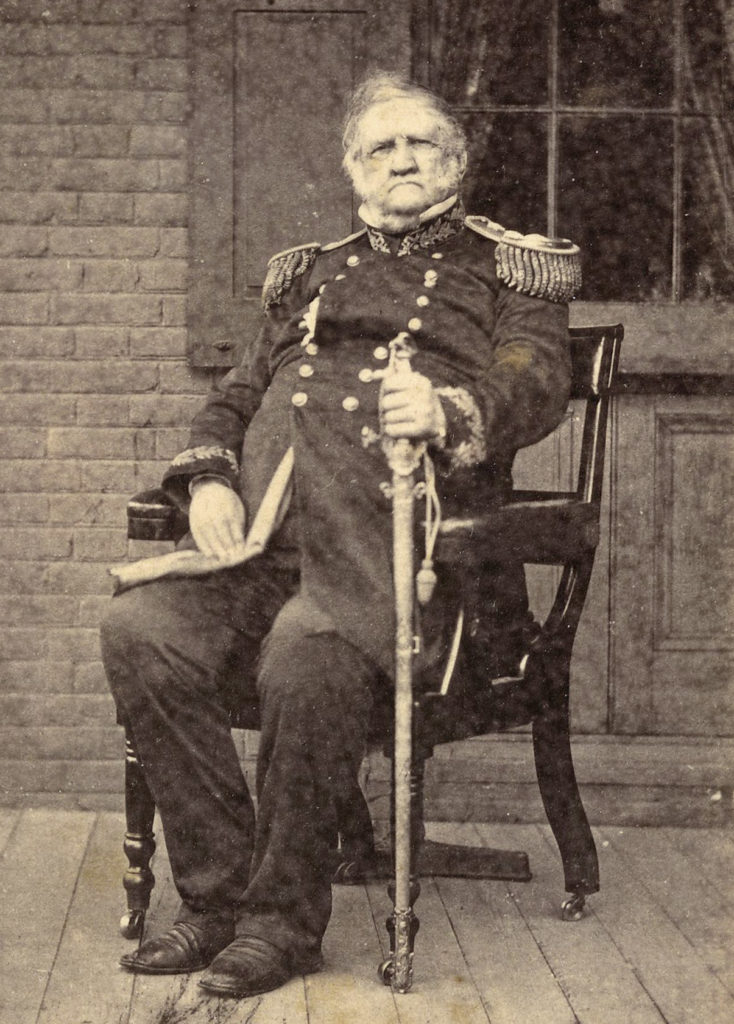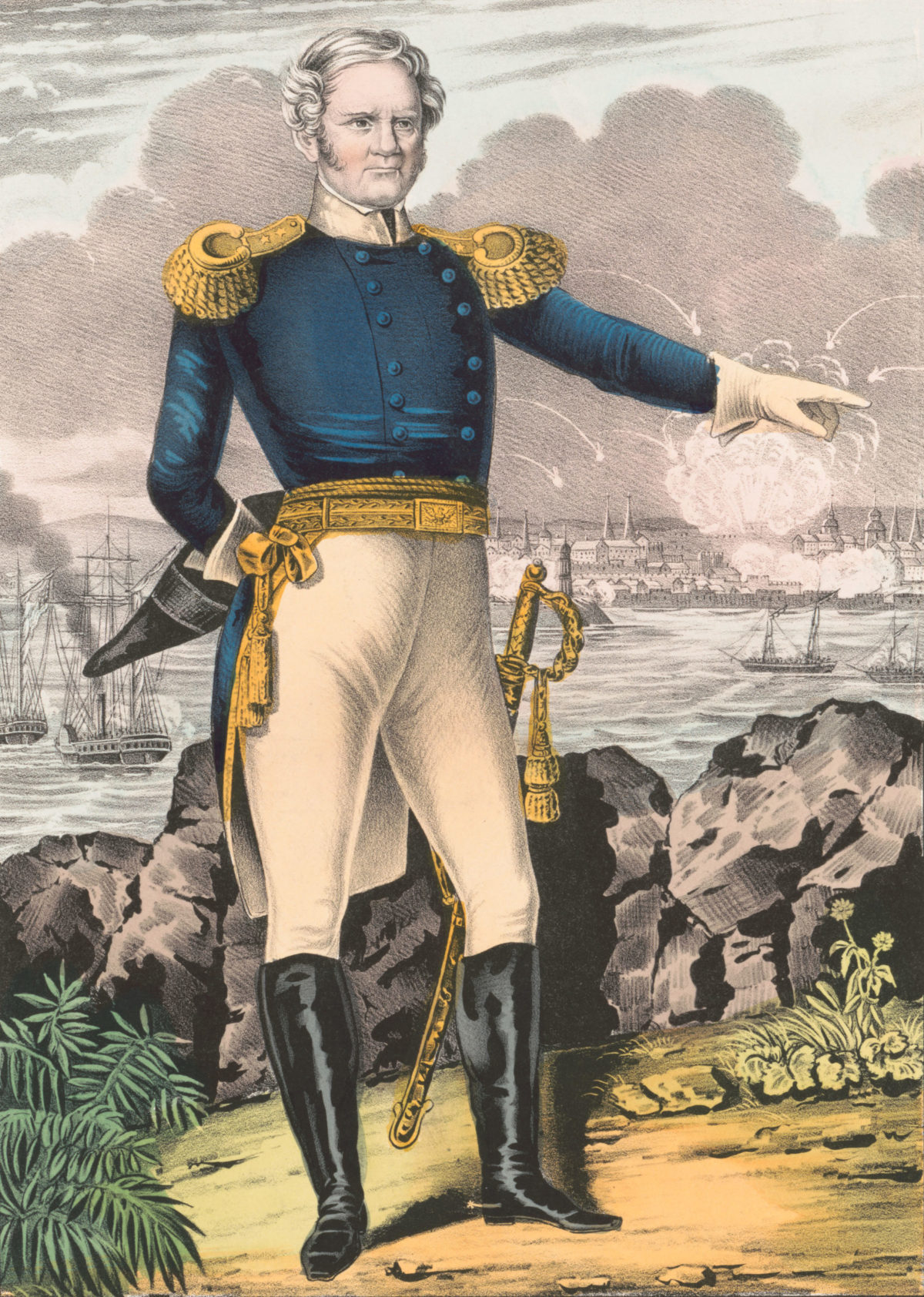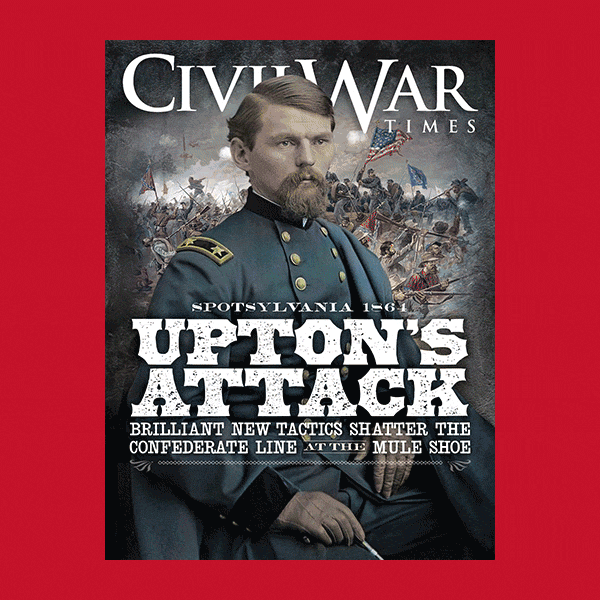Winfield Scott’s accomplishments place him among the five greatest soldiers in U.S. history—in company with George Washington, Ulysses S. Grant, Dwight D. Eisenhower, and George C. Marshall. Between the War of 1812 and the Civil War, Scott did as much as anyone to forge the nation’s professional army and served as its general in chief between 1841 and 1861. His campaign from Veracruz to Mexico City in 1847 prompted the Duke of Wellington to laud him as “the greatest soldier of the age.” Many junior officers in Mexico gained knowledge under Scott that they applied when in charge of their own armies during the Civil War. For his accomplishments in Mexico, Scott was brevetted lieutenant general, a regular rank held only by Washington until conferred on Grant in early 1864.
Yet the Winfield Scott of 1861 invites caricature. Nearly 74 years old, he sometimes nodded off during meetings. Once a striking figure at 6-feet-5 and partial to uniforms that explained the nickname “Old Fuss and Feathers,” he had inspired West Point cadet Ulysses Grant to call him “the finest specimen of manhood my eyes ever beheld.” But more than 350 pounds draped his large frame by 1861, gout and other ailments tormented him, and mounting a horse required the help of special winches. His strategic suggestions in the spring of 1861, which featured a coastal blockade and seizing control of the Mississippi River to choke the Rebel states, received considerable scorn as the “Anaconda Plan.” Most of the loyal citizenry preferred a shorter, more direct approach that would smash Confederate forces and end the rebellion in a single dramatic stroke.
During the summer and autumn of 1861, Scott and Maj. Gen. George B. McClellan increasingly locked horns. One of the young officers in Mexico who profited from Scott’s example, McClellan initially spoke well of his superior. “All that I know of war I have learned from you,” Little Mac wrote while operating in western Virginia, “& in all that I have done I have endeavored to conform to your manner of conducting a campaign.” Forty years Scott’s junior, McClellan changed tone as he imagined himself in overall charge of U.S. forces. He oozed condescension and self-aggrandizement when remarking of his superior in August: “I do not know whether he is a dotard or a traitor! I can’t tell which. He cannot or will not comprehend the condition in which we are placed & is entirely unequal to the emergency.”
Ailing and fed up with McClellan’s behavior, Scott decided to retire. Attorney General Edward Bates’ diary noted on November 1, 1861: “A Memorable Day. C.[abinet] C.[ouncil] called at the unusual hour of 9 a.m. to consider of Gen. Scott’s letter to Sec: [of] War, declaring his wish, by reason of age and increased ill health, to retire from active military duty….The order was drawn up by the President himself…and was done chastely and in excellent taste….The Prest. made a neat and feeling address, and the Genl. briefly replied, from the depths of his heart—”
McClellan’s claim that Scott proved unequal to the crisis of 1861 did the old soldier a great disservice. Although physically declining, the general in chief retained a first-rate mind and drew on vast experience as he pondered how best to defeat the Confederacy. The example of Mexico in 1846-48 probably guided some of his thinking. The United States had blockaded Mexican ports on the east coast and struck the northern provinces of Alta California, New Mexico, Coahuila, Nuevo Leon, and Chihuahua. When those strategic elements proved insufficient, Scott’s famous campaign directed U.S. military power into the heart of Mexico.
On May 3, 1861, Scott laid out his thinking to McClellan. He proposed a “complete blockade of the Atlantic and Gulf ports” together with “a powerful movement down the Mississippi to the ocean.” The latter would require perhaps 60,000 “of our best regulars and of three-years’ volunteers, all well officered, and with four months and a half of instruction camps….” Forces on the Mississippi would turn successive Confederate strongholds and establish garrisoned posts as the campaign progressed. Impatience on the part of “our patriotic and loyal Union friends” posed the “greatest obstacle in the way of this plan,” thought Scott: “They will urge instant and vigorous action, regardless, I fear, of consequences.”
Scott’s letter to McClellan showed a mature grasp of the need to prepare and carefully train green volunteers and avoid the chimera of a quick, decisive battle. It also signaled a willingness to wait while possibly slow-moving operations cut sources of supply and sheared off the Trans-Mississippi section of the Confederacy. Critics at the time and later labeled the plan too passive, a case of Scott’s willingness to sit back and allow the blockade and seizure of the Mississippi River to precipitate a Confederate collapse. Where was the equivalent of his campaign against Mexico City?

In fact, Scott foresaw large-scale invasions of the South as a possible feature of Federal operational strategy. On March 3, 1861—long before the Confederacy showed it could mount an impressive military effort—he advised incoming Secretary of State William H. Seward that the U.S. might have to “[c]onquer the seceding States by invading armies.” The effort could take two or three years and “three hundred thousand disciplined” soldiers, many thousands of whom would be lost “by skirmishes, sieges, battles, and Southern fevers.” “The destruction of life and property on the other side would be frightful—however perfect the moral discipline of the invaders,” counseled Scott, and would entail a toll of “enormous waste of human life to the North and Northwest” and bitter postwar feelings that would frustrate the national goal of speedy reunion.
Scott’s letters to Seward and McClellan proved remarkably prescient regarding the war, its cost, and its messy and violent aftermath. Although underestimating both length of time and number of invading troops, he anticipated the Union’s winning strategy—blockade the Rebels, divide their territory by seizing the Mississippi, and send armies into the Confederate hinterlands. Scott spent most of his retirement at West Point, where he wrote his memoirs and watched the war unfold much as he had envisioned. He died in 1866 and lies buried in the Academy’s cemetery.






